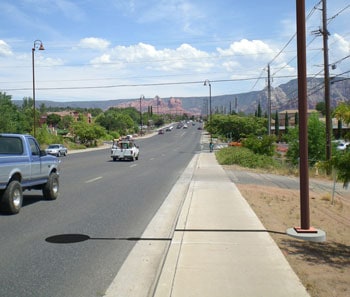Sedona’s connection to Frank Lloyd Wright began when Victor Sidy moved here from Los Angeles in 1982.
Still in grade school, the student was drawn to the violin, thinking for a time he might become a composer, but also enjoying the experience of forming clay on his mother’s potter’s wheel.
Even more, he embraced the outdoors.
“When you live in Sedona, your backyard can be expansive,” Sidy said. “Building forts in the trees and mud castles in the washes was a passion of mine.”
His sixth-grade teacher at the Brewer Road School was John Kline who remembers Sidy well.
“I’ve had some really good students who’ve gone on to get their doctorates, but Victor was in some ways the finest student I ever had,” Kline said.
Kline doubled as his music instructor and said the student approached the violin and the viola with the same passion as he approached every other subject.
“Of course, it was like everything else he did … he played a solo at his own graduation from sixth grade,” Kline remembered.
In addition to teaching, Kline introduced his student to his son-in-law, John Sather, an architect.
Through this early relationship, Sidy increased his exposure to building and the function of design.
At about the same time, the 12-year-old was forever influenced by a trip to Paolo Solari’s Arcosanti.
“It’s bold, an experiment that does to the landscape what a young person wants it to do — celebrating broad landscapes with a beautiful set of buildings,” Sidy said. “It takes into account the cycles of sun and wind, its wonderful half-domes collecting winter sun and providing shade in the summer.”
By the time he was a teenager, there was a lot of development going on in Sedona, drawing his curiosity.
“I found it wonderful to walk around construction sites and to see how things were built,” Sidy said. “It became clear to me that some houses were designed better than others and I was lucky enough to meet some of the architects. It was easy to contrast their work against crass developers who had little regard for the location they were building on and it made me realize building could be done sensitively — or not.”
At the time, Sedona was yet to have a high school, so he commuted to Flagstaff for classes.
“It was there I saw architecture could be viewed through a variety of lenses — math, history, a perceptive eye, communication, how things go together scientifically,” Sidy said. “An architect has to be a polymath and Flagstaff High School allowed me to explore those various disciplines instead of choosing just one.”
Dee Chadwick of the Village of Oak Creek was one of his instructors.
“Victor was advanced placement in 1992-1993,” Chadwick said. “He and his classmates set the standard for all who were to come. He showed outstanding intellectual curiosity, bringing up and often leading conversations about Shakespeare, Camus, Fitzgerald, Sophocles — we read them all. I think I learned as much from that class as they did from me.”
As graduation neared, Sidy was still unsure of his future course of study, but when one of his parents’ friends described architecture as frozen music, he realized he didn’t have to give up one for the other, that his interests in composing music and composing spaces might be combined.
Shortly afterward, the senior was informed he was the recipient of the prestigious Flynn Foundation Scholarship.
“Even though he’d won honors in science and math, he chose me to go to the presentation,” Kline said. “What else could I do but make him a gift of my viola.”
Sidy first enrolled at Arizona State University in Tempe, but then heard about Taliesin West and the Frank Lloyd Wright Foundation that runs the school of architecture, prompting him to take a year-long leave of absence from ASU.
When the year was up, he stayed on, earning an undergraduate degree and a master’s in architecture, then went to work with the largest private Montessori school in the country, designing for them a nature-based campus.
At the same time, Sidy was also teaching architecture and design to the school’s students and establishing a private practice nearby in Dallas.
When Saskia, his wife, was accepted at the School of Visual Arts in Manhattan, the couple relocated to New York and Sidy was just getting involved in loft redesign when he was contacted by his alma mater.
“When the call came in asking me to throw my hat in the ring for leadership at Frank Lloyd Wright, it caught me off guard,” Sidy said. “But, then I realized my work at Montessori gave me insight into how to manage small academic institutions.”
As the youngest dean at a school steeped in history yet built upon an avant-garde set of ideas, one of his challenges would be to honor the past while looking to the future.
Complicating those plans was a school changed in the 10 years since his graduation.
“The strong culture of architectural practice had devolved into academics,” Sidy said. “I wanted students to understand not only architectural theory, but how to build things because that’s at the core of making the invisible visible. That’s what made my own education so exciting — real projects that were compelling — cultivating relationships with clients and other architects and builders.”
Before he could reintroduce the passion of building for real, the brand new dean had major financial problems to fix.
“Two weeks after I started, the school was put on notice by its creditors,” Sidy said. “It was a clarion call for change and we spent the better part of two years addressing their concerns.”
Today, three and a half years into his tenure, his school’s program is one of the few centered around hands-on learning, allowing students to discover early on what it takes to get something built — a place where any impassioned student would want to test their skills.
With 24 students enrolled, four permanent faculty members and 15 adjunct instructors, the school is currently at capacity; however, Sidy thinks 40 students would be ideal, planning incremental expansion.
Currently, its highest-profile project is a collaboration with the Guggenheim Museum in New York, celebrating the 50th anniversary of their building and commemorating the 50th passing of Frank Lloyd Wright.
Sidy would also like the school to participate in the future development of Arizona.
“I love Arizona; I missed it when I was away — the power of its landscapes, the poetry of its seasons, even the smell of the rain,” Sidy said. “But I’m disappointed at the level of destruction that’s gone on in Sedona, Prescott and Phoenix. As a state we need to do a better job of tending to the land, using synergistic approaches to building through thoughtful design.





















